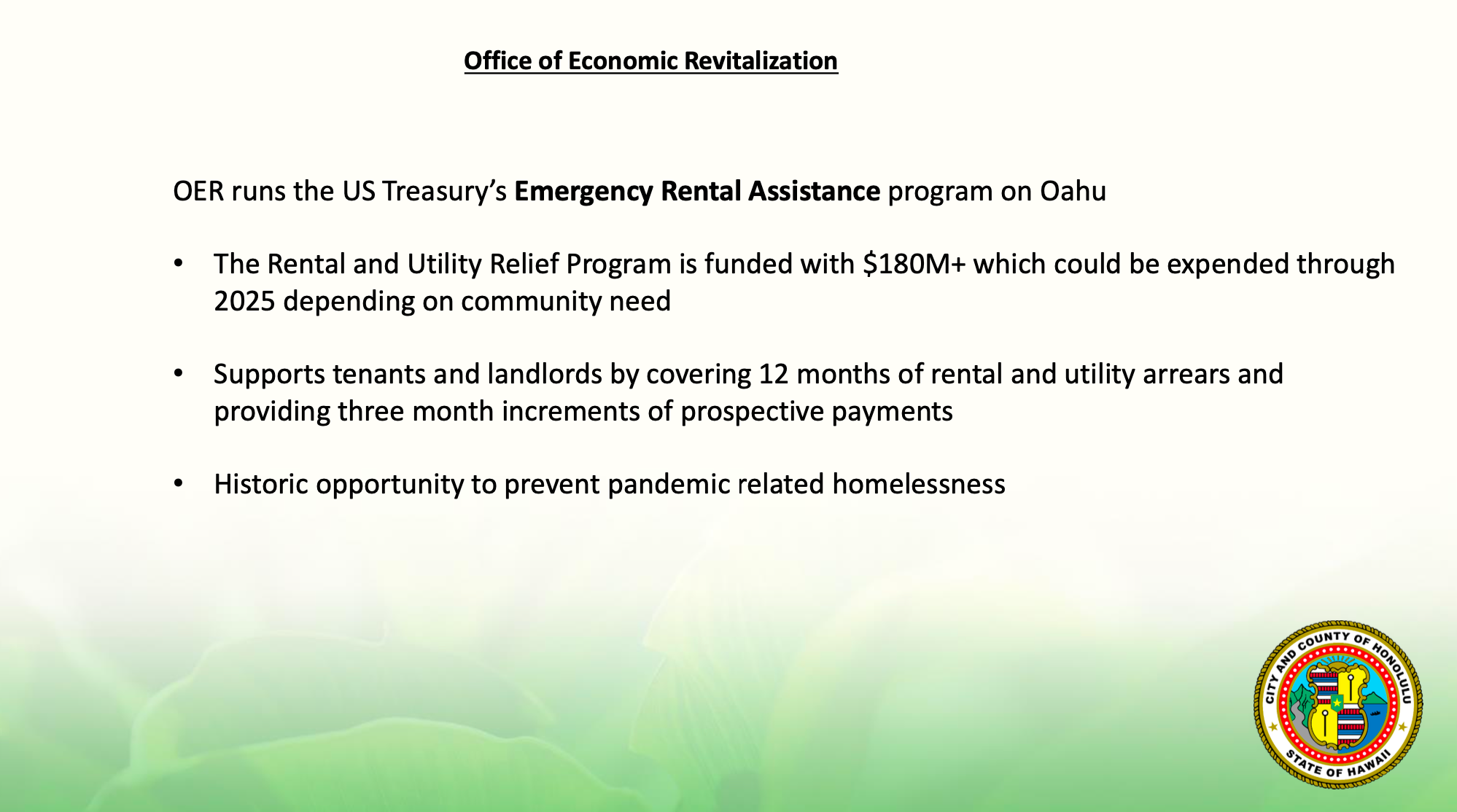If trends continue, Hawaiʻi would have enough federal rental assistance funds to help every household that’s behind on rent, according to US Treasury data and two national estimates. The Treasury data also suggests that Hawaiʻi — in particular, the City and County of Honolulu — is distributing those rental assistance funds faster than most of the country.
But it’s still a race against the clock with the CDC’s eviction moratorium no longer in effect. Tenants and advocates have raised concerns about accessing the state’s rental assistance programs and some landlords’ unwillingness to take government rental assistance funds. On August 27, more than 200 community organizations, elected officials, and other individuals sent a letter to Gov. Ige asking him to reinstate the state’s eviction moratorium, led by HOPE Services Hawaiʻi and the Medical Legal-Partnership for Children in Hawaiʻi.
Recent Treasury data compares governments’ spending of Emergency Rental Assistance funds
The City and County of Honolulu has distributed a greater share of its federal Emergency Rental Assistance (ERA) funds than 94% of other state, local, and territorial governments, according to US Treasury data released on August 25.
Honolulu received $61.9 million in federal funds earlier this year to assist households that can’t pay rent or utilities due to the pandemic. As of July 31, the City had distributed over 70% of that allocation — or $44 million — to 5,600 Oʻahu households, according to the Treasury report.
Nationally, the Treasury reported that less than 20% of those federal rental assistance funds have been distributed. Honolulu is one of only 32 governments that have distributed 70% or more of their ERA funds, according to the Treasury report.
Those funds are from the first round of the ERA program, which was originally enacted in December 2020. The state government, Hawaiʻi County, and the Department of Hawaiian Home Lands also received allocations from the first round, called “ERA1.” More ERA funds (“ERA2”) are coming from the 2021 American Rescue Plan Act. Those funds comprise part of the City’s $180 million Rental and Utility Relief Program.

The Treasury data only goes through July 31, and both the City and County of Honolulu and Hawaiʻi County report higher current figures on their websites than the Treasury report. As of August 30, the City said it had “approved” $60.3 million in assistance (of its $61.9 million total), and Hawaiʻi County said it had “disbursed” $4.4 million (of $12.8 million total).
The state government received the greatest share of funds — $125.2 million — and according to the Treasury report, has distributed about 10% as assistance to households. (The state ERA funds are “being administered by the counties in an effort to infuse the funds into the community faster, increase efficiency and reduce the chance for duplicating payments,” according to the state.) The Department of Hawaiian Home Lands received $2.4 million, but the Treasury report yet doesn’t include any distributions to households.
The state, county governments, and community partners continue to urge households to apply for assistance.
Overall, 1 in 22 renters in Hawaiʻi have been helped with ERA funds so far — the seventh highest in the country — according to one analysis.
Based on the new ERA data, I think these are the best performing states (including localities) in terms of % of renters assisted. (Some renters may have received assistance on multiple occasions, so I also included the average amount of each ERA payment.)https://t.co/LMOFGy1TaA pic.twitter.com/qUt7eniumQ
— Ryan Radia (@RyanRadia) August 25, 2021
Amount of federal rental relief funds lines up with estimates of households behind on rent
As of July 31, there were $143 million in ERA1 funds remaining statewide, according to the Treasury report. Thus far, households have received an average distribution of about $7,000. More recently, Honolulu’s OneOahu.org reports that households have been receiving around $8,000, on average. If this trend continues, some back-of-the-napkin math suggests that Hawaiʻi could help more than 17,000–20,000 more households with just this first tranche of ERA funds.
That’s in the ballpark of the number of households behind on rent by the end of July, according to two recent analyses. The National Equity Atlas estimated there were 16,000 Hawaiʻi households behind on rent, with $87.4 million total in rent debt. Surgo Ventures put the number at about 27,000 households, totaling $153.2 million in debt.


Hawaiʻi is set to receive about $166 million with the next round of ERA funds. If households continue to receive an average of $7,000–$8,000, then after adding in this second tranche, there would be enough funding for a total of roughly 36,000–43,000 households.
This is as Congress designed when approving the ERA program. “Estimates from the Right to the City Alliance indicate that there’s about $21.3 billion in total rental debt across the United States. Congress actually stepped up to provide those funds: More than twice that number has been allocated in rental assistance,” according to the American Prospect.
“There should be no evictions in Hawaiʻi when federal funds are available to ensure tenants can remain current on their rent and landlords can be made whole,” US Rep. Kai Kahele wrote to Gov. Ige earlier in August, according to Civil Beat.
Where to find help
The state has a summary of how to apply to each Emergency Rental Assistance program, and these are the direct links:
Other resources:
- Additional resources from the Office of the Governor’s Coordinator on Homelessness.
- FAQs about tenants’ rights with the end of the CDC eviction moratorium: PDF, website from the state Office of Consumer Protection.
- Eviction resources from Legal Aid Hawaiʻi (available in multiple languages).
- HCAN’s map to find a vaccine or testing site near you.
